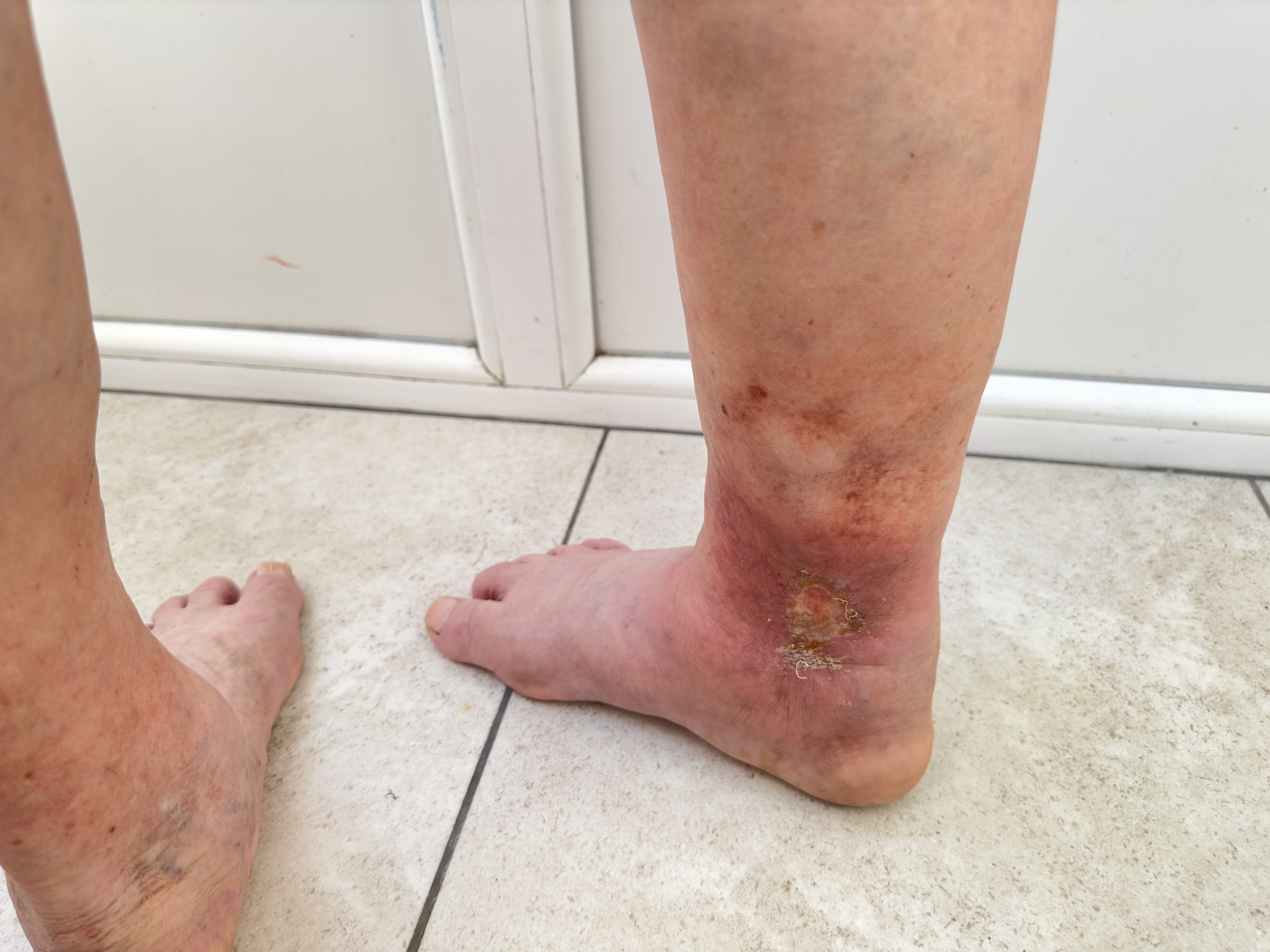If you’ve ever been told to wear anti-embolism stockings, you might have wondered …. do they really make a difference? It’s a fair question, after all they look a lot like regular compression socks, and unless you’ve been through surgery or dealt with swelling, you may not have heard much about them.
The truth is, anti-embolism stockings are more than just another medical garment. They’re a proven, medically recommended tool for helping prevent deep vein thrombosis (DVT), a condition where dangerous blood clots form, often in the legs, when blood flow slows down. Doctors prescribe them for people recovering from surgery, those spending long periods in bed, or anyone at higher risk of clotting and swelling.
At Care-Med, we’ve seen first-hand how important the right stockings can be. As certified compression specialists, we work with patients managing DVT risk, lymphedema, lipedema, and edema, making sure they get the right fit and the right guidance. Our goal is to help people feel safer, recover better, and stay comfortable.
What Are Anti-Embolism Stockings?
Anti-embolism stockings are a type of medical garment designed to gently support blood flow in the legs. They apply light, graduated pressure that’s strongest at the ankle and gradually lessens as it moves up the leg. This subtle squeeze helps keep blood moving, which lowers the chance of clots forming when someone is less active.
It’s easy to confuse anti-embolism stockings with regular compression socks, but they’re not quite the same. Compression socks are usually firmer and are often worn by people who are on their feet for long hours, traveling, or managing ongoing circulation issues. Anti-embolism stockings are specifically made for recovery and immobility, for example, after surgery or during hospital stays.
Think of them as gentle helpers for your circulation when you can’t be up and moving around as much as you’d like. By reducing the risk of deep vein thrombosis (DVT) and easing swelling, they play a quiet but important part with protecting your health during vulnerable times.
How Anti-Embolism Stockings Help Prevent DVT
Deep vein thrombosis (DVT) happens when blood flow slows down enough for a clot to form, most often in the legs. The risk is higher if you’ve been through surgery, are on bed rest, or spend long stretches without moving much. The concern isn’t just the clot itself, if it travels, it can become dangerous. That’s why prevention is so important.
Anti-embolism stockings help by giving your circulation a gentle push in the right direction. The light, graduated pressure keeps blood moving steadily back up toward the heart, instead of pooling in the lower legs. You can think of it as giving your veins a little extra assist when your muscles aren’t doing the work of walking or moving.
Hospitals rely on them for patients after surgery, and doctors often recommend them for anyone who needs extra support to reduce their risk of clots.
Benefits Beyond DVT Prevention
Although the main goal of anti-embolism stockings is to reduce the risk of blood clots, that’s not the only benefit they bring. Many people notice they also help with swelling (edema), especially in the lower legs and ankles. By gently encouraging circulation, they reduce the heavy, achy feeling that often comes with fluid buildup.
They can also make recovery more comfortable. After surgery or during long hospital stays, it’s common to feel sluggish and sore in the legs. Wearing anti-embolism stockings helps ease that discomfort by keeping blood and fluid moving, even when activity is limited.
For people living with ongoing circulation challenges, like lymphedema, lipedema, or chronic swelling, these stockings can be part of a broader care plan. They don’t replace medical treatment, but they add an extra layer of support that makes day-to-day life a little easier.
When You Should Talk to a Specialist
Anti-embolism stockings are most effective when they fit properly and are used in the right situations. Because every person’s health needs are different, it’s always best to check with a healthcare professional before relying on them.
A specialist can help determine whether anti-embolism stockings are the right option for you, and if so, which size and style will provide the safest support. Proper fit matters, stockings that are too loose won’t do much good, and ones that are too tight may be uncomfortable or even counterproductive.
If you’re recovering from surgery, have limited mobility, or are at higher risk for blood clots, talking with a certified compression garment fitter at Care-Med or your doctor can give you peace of mind.
Questions That Come Up Most Often
It’s normal to have questions about anti-embolism stockings. They might look simple, but they serve a very specific medical purpose, and it’s not always clear when or how they should be used. Patients often wonder how long to wear them, whether they’re helpful outside of hospital recovery, or how they compare to other types of compression wear.
How long should I wear anti-embolism stockings each day?
It depends on your situation and your doctor’s instructions. After surgery or during recovery, stockings are often worn most of the day, and sometimes even overnight, especially in the first critical days when you’re less mobile. The goal is to keep circulation steady whenever you’re inactive.
Once you’re up and moving regularly, your healthcare provider may recommend wearing them for fewer hours. The most important thing is to follow their guidance, since the duration can vary from person to person.
Can I use anti-embolism stockings for travel or everyday swelling?
Not usually. Anti-embolism stockings are made specifically for recovery and immobility, such as after surgery or during extended hospital stays. They provide lighter, graduated pressure that’s meant for people who are lying down or moving very little.
For travel (like long flights) or daily swelling from standing or sitting, compression stockings are generally a better choice because they’re designed for active or semi-active use.
What’s the difference between anti-embolism stockings and compression stockings?
Although they look similar, the two serve different purposes. Anti-embolism stockings use gentler pressure and are intended for patients who are less mobile, helping to prevent clots during recovery. Compression stockings apply stronger, sustained pressure and are designed for ongoing use in daily life, for example, to ease varicose veins, manage chronic swelling, or prevent clotting during long periods of sitting or standing.
Can anti-embolism stockings be reused after recovery?
In most cases, anti-embolism stockings are meant for short-term use and may lose their effectiveness over time. The elastic fibers that provide compression can stretch out, especially with frequent washing.
If you need ongoing support after recovery, your healthcare provider will usually recommend switching to medical-grade compression stockings, which are made for long-term wear.
How do I know if my stockings fit properly?
A proper fit is important. Stockings that are too loose won’t provide enough pressure, while ones that are too tight can be uncomfortable or even harmful. Signs of a good fit include even, gentle pressure without pinching, no rolling down at the top, and no bunching around the ankles or knees.
If you’re unsure, a certified fitter or healthcare professional can take leg measurements and make sure you’re wearing the right size. At Care-Med, our certified fitters are available to help. Email or call 416-782-5353 to book an appointment for a personalized fitting.
Do Anti-Embolism Stockings Really Work?
So…do anti-embolism stockings really prevent DVT? The answer is yes, when worn as directed, they have proven to lower clot risk and support healthy circulation during times of reduced mobility. They may look simple, but their impact can be significant, whether it’s protecting against blood clots, reducing swelling, or making recovery more comfortable.
These stockings aren’t about making life more complicated, they’re about making recovery safer and easing one less worry during a vulnerable time. With the right fit and proper guidance, anti-embolism stockings are a small step that can make a big difference.
Share This Story, Choose Your Platform!
Table of Contents
We specialize in orthotics, body braces, and compression wear tailored to your unique needs in Toronto. Reach out to us at info@caremed.care or call 416-782-5353 to book your fitting and consultation.
Experience the difference of customized solutions designed just for you.











